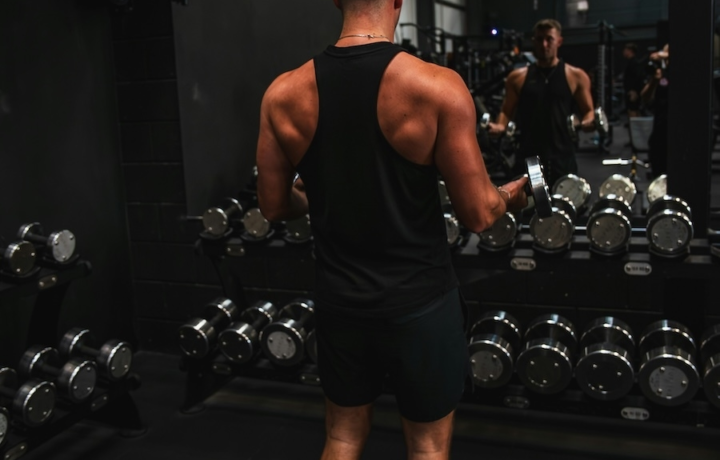Exercise
Cable Curl

Cable Curl
How to Perform
- Stand facing the cable machine with your feet shoulder-width apart and grip the cable attachment with an underhand grip, palms facing up.
- Position your elbows close to your sides and allow your arms to fully extend toward the machine, maintaining a slight bend in your elbows to reduce joint stress.
- Engage your core and maintain a neutral spine position with your shoulders pulled back and down throughout the movement.
- Exhale as you slowly curl the attachment toward your shoulders, keeping your upper arms stationary and elbows fixed at your sides.
- Focus on contracting your biceps at the top of the movement, pausing briefly when your forearms are vertical and hands are near shoulder level.
- Inhale as you slowly lower the weight back to the starting position with control, resisting the pull of the cable.
- Maintain tension in your biceps throughout the entire range of motion, avoiding the tendency to fully relax at the bottom of the movement.
- Keep your wrists neutral (not flexed or extended) throughout the exercise to maximize bicep activation and minimize forearm strain.
Important information
- Make sure your elbows stay pinned to your sides throughout the movement to isolate the biceps and prevent swinging.
- Adjust the weight to allow for proper form—using too much weight will cause you to use momentum and reduce bicep activation.
- Keep your back straight and avoid leaning backward during the curl, as this shifts the work away from the biceps and can strain your lower back.
- For variety, try different cable attachments (straight bar, EZ bar, rope) to change the angle of resistance and target different parts of the biceps.

Cable Curl
Exercise Details
Primary Muscles
Muscle Groups
Mechanic
Built for progress
Take the guesswork out of training
Create personalized AI-powered workout plans that evolve with you. Train smarter, track every rep and keep moving forward, one workout at a time.






The cable curl stands as a cornerstone biceps exercise in any serious bodybuilding or strength training program. This intermediate-level movement offers unique advantages that traditional free-weight curls simply can't match. The constant tension provided by the cable machine keeps your biceps engaged throughout the entire range of motion, eliminating those rest points that occur at the top and bottom of dumbbell or barbell curls.
When incorporated into a well-designed upper body routine, cable curls deliver that coveted muscle pump while contributing significantly to biceps hypertrophy. The exercise targets the entire biceps brachii, with secondary activation of the brachialis and brachioradialis, making it an efficient choice for those seeking balanced arm development. Strength athletes particularly appreciate how cable curls allow for precise loading that can be adjusted in smaller increments than plate-loaded options.
For intermediate lifters looking to break through plateaus, cable curls provide the perfect blend of stability and challenge. The predictable resistance pattern makes this an excellent exercise for focusing on mind-muscle connection, a crucial element for bodybuilders seeking to maximize muscle engagement. Many seasoned trainers recommend cable curls as a finisher after heavier compound movements have pre-exhausted the arms.
The versatility of cable curls extends to their programming potential. They work exceptionally well in traditional hypertrophy protocols (3-4 sets of 8-12 reps), but also shine in higher-volume approaches or drop sets that push the biceps to their limits. For strength-focused individuals, heavier loads with lower repetitions can effectively build the biceps' peak strength while maintaining joint health due to the smoother resistance curve compared to free weights.
Whether you're prioritizing aesthetic development or functional strength, cable curls deserve a permanent place in your arm training arsenal. Their combination of constant tension, customizable resistance, and excellent isolation makes them an irreplaceable tool for anyone serious about developing impressive biceps.
FAQ - Cable Curl
The cable curl primarily targets the biceps brachii (both the long and short heads), while also engaging the brachialis and brachioradialis as secondary muscles. This comprehensive activation makes it superior to many other biceps exercises for balanced arm development.
Unlike free-weight curls, cable curls maintain constant tension throughout the entire range of motion, eliminating rest points at the top and bottom of the movement. This continuous resistance leads to greater time under tension and potentially better muscle growth stimulus.
The most common mistakes include swinging the torso to move the weight, allowing elbows to drift forward, and using momentum instead of biceps strength. Keep your upper arms pinned to your sides, maintain a stable torso position, and focus on moving only at the elbow joint.
For optimal biceps development, incorporate cable curls 1-2 times weekly with at least 48 hours between sessions for recovery. They work best as part of a comprehensive arm training program, either as a primary movement or as a finisher after compound exercises.
Beyond increasing weight, you can intensify cable curls by implementing drop sets, extending time under tension with slower negatives, using single-arm variations for greater focus, or adjusting your stance or cable height to target different portions of the biceps.






